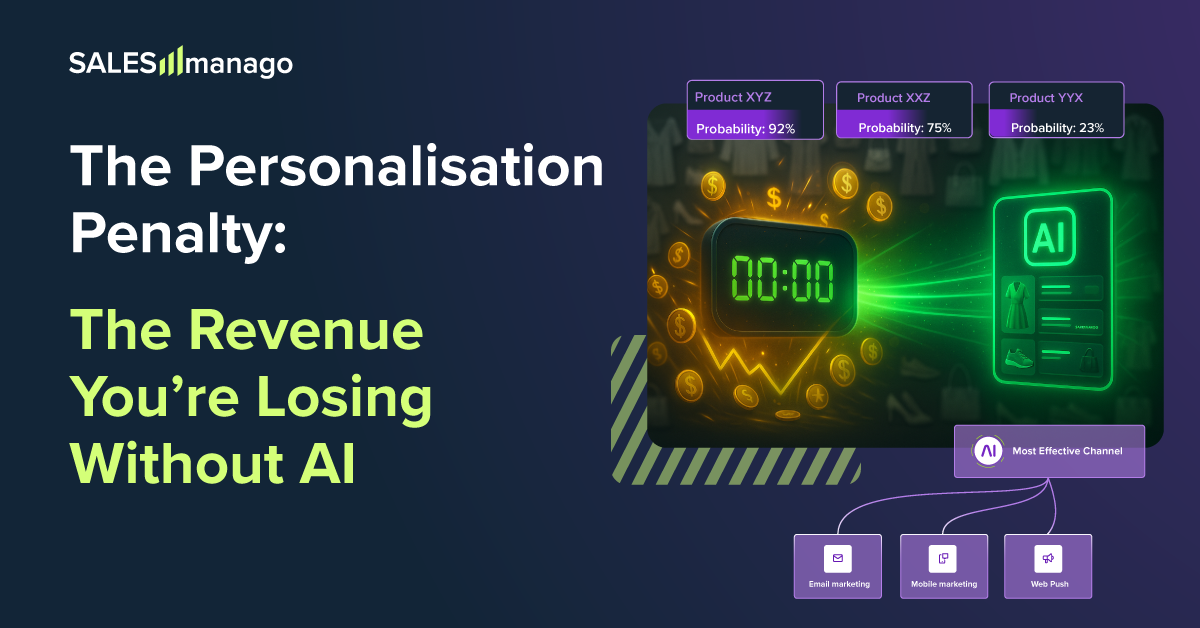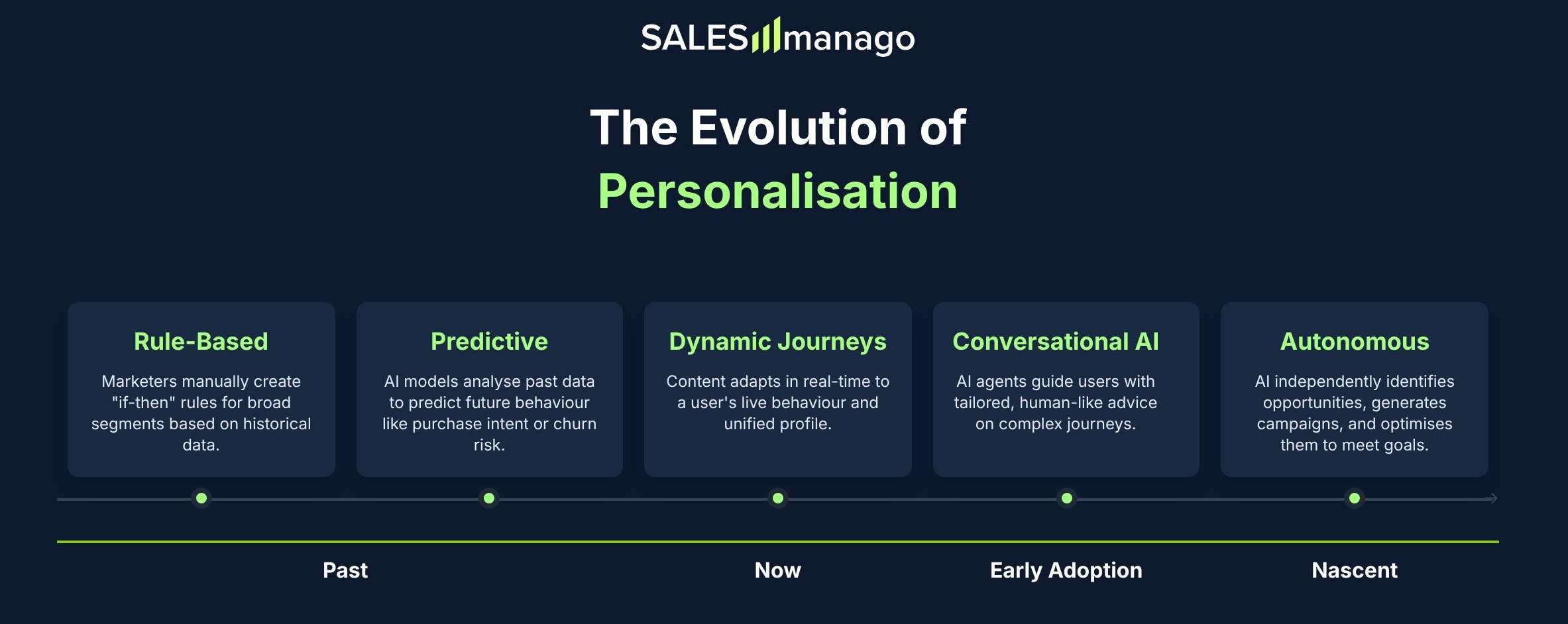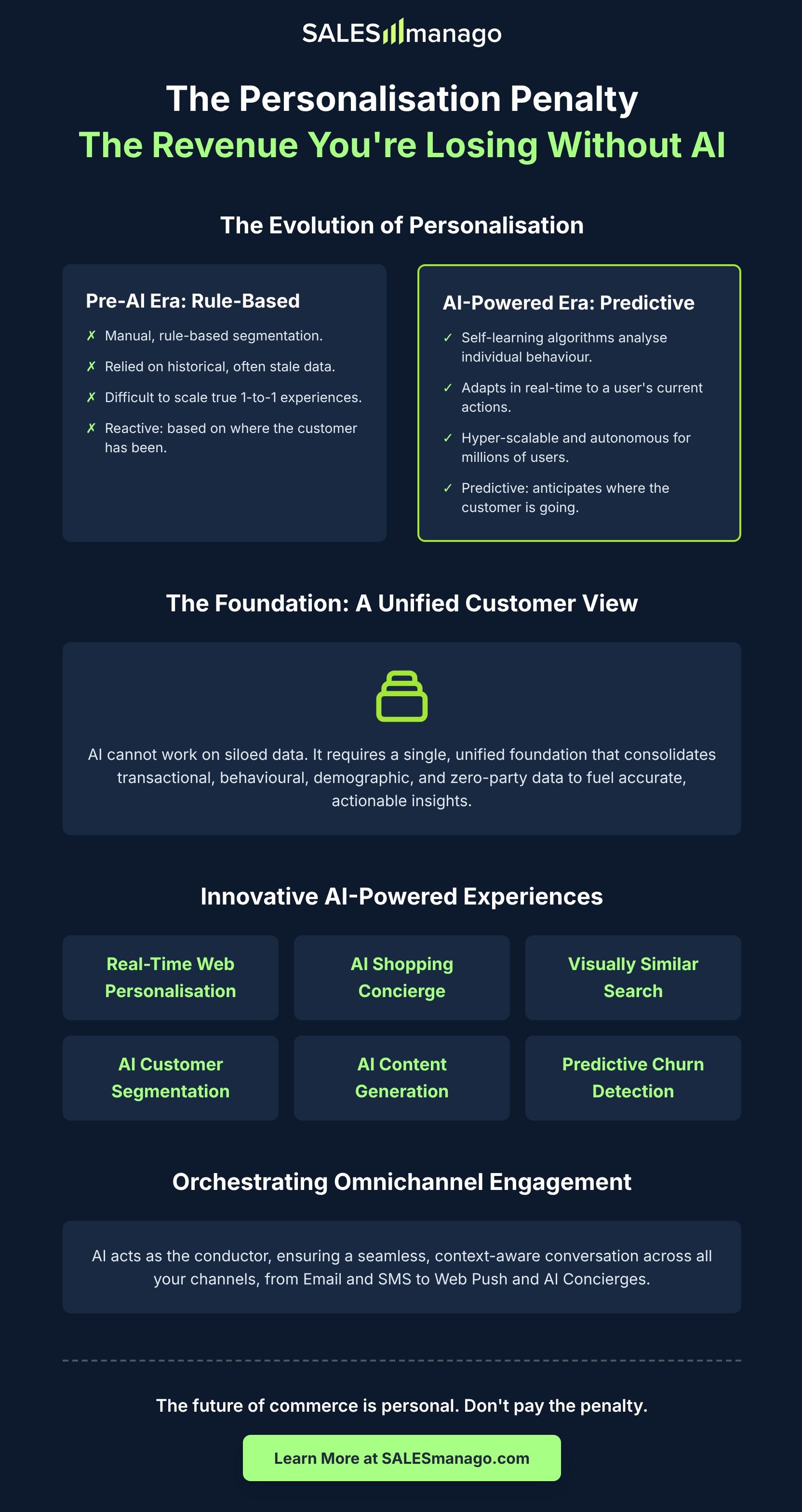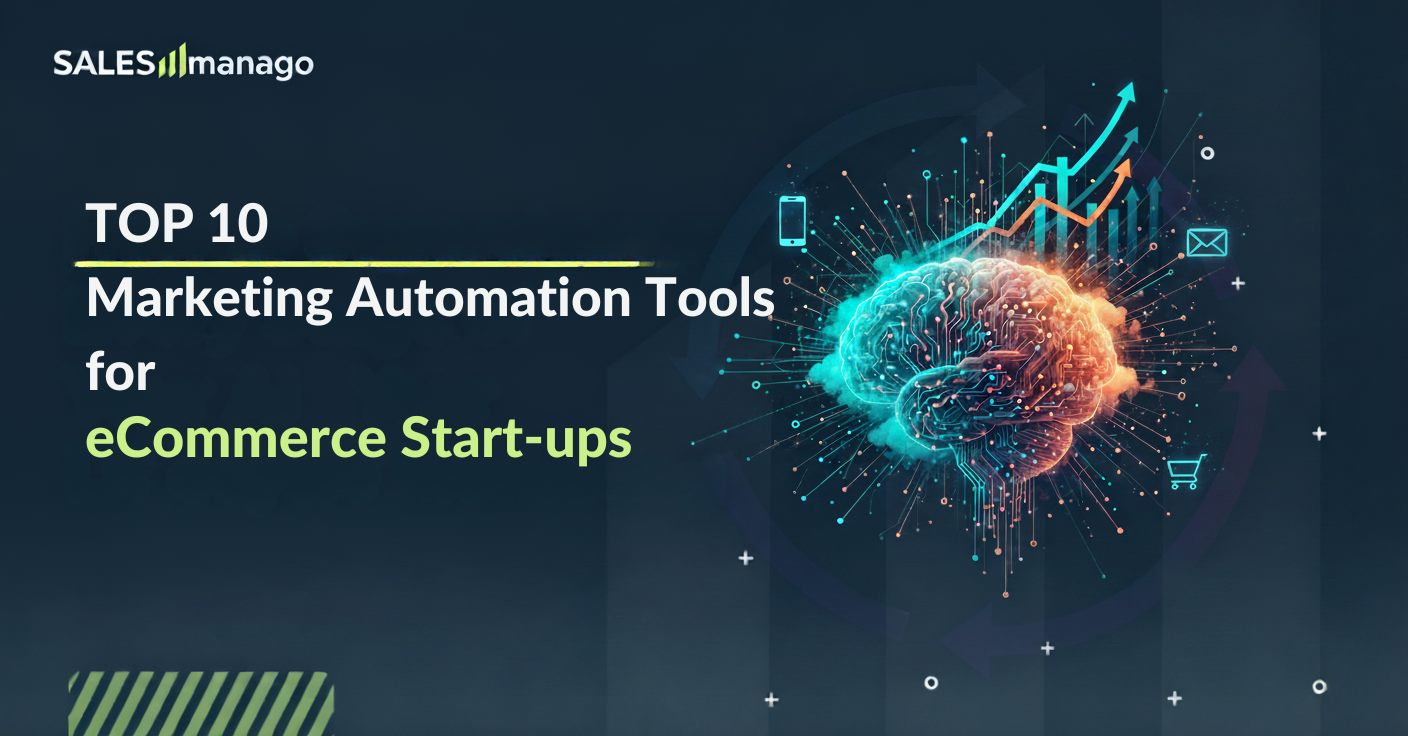
If you are working in eCommerce or any other industry that deals with customers, you know it already. There's a revenue penalty, one that grows with every customer interaction that falls short of their expectations. I call it the Personalisation Penalty.
It's the cumulative loss of sales, loyalty, brand perception, and market share that businesses incur by failing to deliver truly individualised tailored customer experiences. This isn't just a concept; it's a multi-trillion-dollar liability. According to a 2024 Qualtrics XM Institute study, $3.8 trillion in global sales are at risk due to poor customer experiences, with a lack of personalisation being a primary driver.
The stark reality is that marketers must now use Artificial Intelligence (AI) to optimise and personalise every single customer touchpoint. AI is no longer a luxury reserved for large, tech-savvy companies - it’s now an essential, accessible tool for (ecommerce) businesses of all sizes; it is a business fundamental for growth and customer retention. Without AI powering your strategy, you’re not just missing revenue - you’re gifting it, and your customers, to faster-moving competitors.
This is not about the future of AI; it's about the immediate cost of inaction and the clear, actionable path to reclaiming that lost revenue.
The Customers Expectations Change Everything
The modern consumer has evolved. Everyday interactions with Amazon, Netflix, and Spotify have fundamentally altered the unspoken contract between brand and consumer. Today, the experience is as important as the product. Consumers no longer only buy products; they have expectations for the experience and their benchmark is set by their engagement with other digital brands. They expect you to know them - as an individual, to anticipate their needs, and to provide a seamless, frictionless path from discovery to purchase and beyond.
This shift from a transactional to an experiential economy means that every non-personalised email, irrelevant offer, or disjointed digital experience is more than just a missed opportunity; it's a breach of this new contract. It actively drives customers away. The expectation is for 1-to-1 engagement, at scale, across the channels of their choice. Ecommerce businesses must therefore move beyond simply having a digital presence and evolve into becoming digital curators of individualised experiences. The alternative is to become obsolete.
This shift is precisely why the global ecommerce personalisation tools market was valued at approximately USD 1.2 billion in 2023 and is anticipated to reach USD 5.8 billion by 2033 according to DHR.

Personalisation in the pre-AI era
Marketing has dramatically evolved from its initial focus on maximum reach with no personalisation. Once the significant impact of personalisation was understood, it became a goal for marketers, but the capabilities of the tools were limited, as was the data available. Initially, personalisation in one of its simplest forms merely consisted of including a person’s first name in an email. A typical next step was a rule-based segmentation of customers; “people who have previously purchased running shoes” and then sending them an offer. It was a manual, time-consuming process, and depending on the message may still not be relevant to them.
While this was a step up from mass-market messaging, it had many limitations. It relied on broad, historical data and treated everyone within a large segment as identical; it didn’t feel personal to the targeted individual. Additionally, the tools available often made execution of a “personalised” campaign slow and tedious. This approach was based on limited customer data and simple descriptive analytics. It’s like looking in the rear-view mirror to decide where to go next; it was based on where the customer had been, not where they were going.
The promise of personalisation existed but was far from being realised based on how it was implemented and the results, while better, didn’t always justify the investment. Marketers began to understand that not only was data important, but having the ability to discover actionable customer insights as being key to delivering personalisation. This next step to diagnostic analytics was key to the next level of pre-AI personalisation. This enabled understanding of the “why” of customer actions; by doing deep dives on the data they could begin to understand what drove engagement and sales.
Personalisation utilised the fact that customer behaviour and motivation were beginning to be understood; by looking at data correlations marketers could understand that certain individuals purchased based on value, others based on brand, or seasonality, etc. Based on this they personalise better, including better segmentation, better messaging and offers, and in some cases better timing of the engagement. Even with all of this, it was just scratching the surface of what could be done for personalisation.
AI personalisation: the new vs the old
AI doesn't just improve on the old model; it is a new model. Instead of a marketer defining a limited set of "if-then" scenarios, AI can analyse millions of data points for every single user, and across all users, in real time - and act independently on them. It shifts the entire paradigm from being reactive to being predictive, personalised, and actioned. AI anticipates what a specific individual customer will want based on their unique data - including up to the second behaviour and can deliver the desired experiences autonomously. .
The difference is not merely an upgrade; it's a revolution in capability, moving from one-to-many communication to true one-to-one engagement.

| Feature | Pre-AI Personalisation | AI-Powered Personalisation |
|---|---|---|
| Logic | Mainly manually created rules applied to pre-defined segments ("Show X to segment Y") | Self-learning algorithms analysing real-time individual behaviour |
| Scale & Scope | Limited to a manageable number of rules, segments and ability to action. Difficult to scale | Hyper-scalable and autonomous, capable of delivering personalised experiences to millions of individual users |
| Personalisation supported | Static personalisation. Changes often require manual intervention and rely on non-real time data updates | Dynamic personalisation. Adapts in real time to a user's current actions on-site as well as using unified profile data |
| Recommendations | Based on simple behavioural segment, demographic, or product affinity data | Predictive based on what this specific customer is likely to buy based on their individual actions and unified profile data |
| Customer Segmentation | Broad customer segments that can be combined (e.g., 'Male, 30-40, living in the UK'), but not individualised | Can be done at a unique individual level using a unified profile using created with multiple real-time data sources (1-to-1 view) |
| Marketer's Role | Rule builder and segment manager. High marketer operational involvement based on the level of personalisation desired | Strategy director and AI oversight. Marketers provide guidance, oversight, and choose how to use insights; less operational and more strategic |
How to Respond to the Personalisation Requirement
Understanding that customer expectations have changed is an important first step; understanding the path to being able to meet them is the difficult next step. The ability to deliver the 1-to-1 experiences that are necessary for long term customer relationships is not built on your ability to execute marketing campaigns - is it built on understanding your customer. This requires the ability to access, integrate, and analyse your most valuable assets - customer data.
Unifying Data true Personalisation
Before you can personalise an experience, you must first understand the individual, which requires having access to data. Advanced levels of personalisation require not only data, but also analytics to discover customer insights. The more data that you have the more insights that are possible. The first and most critical step in responding is understanding where all of your customer data exists.
The Problem of Siloed Data
For most organisations, customer data is scattered across the business, often trapped in isolated systems. Your transactional data is in your eCommerce platform, website behaviour is in your analytics tool, campaign engagement is in your marketing automation platform, and customer service and support interactions are in CRM.
Attempting to run an AI based approach on a fragmented data foundation is not a recipe for success. The results will not provide the high-definition view of the customer you are looking for; but rather just individual pixels of information - not the complete picture. This can lead to frustrating user experiences, such as being recommended a product you have already purchased, or receiving a generic "we miss you" email after having just visited and engaged on the website. It's inefficient, wastes marketing spend, and damages customer perception of your brand.
The Solution: A Unified Foundation
To deliver AI-driven personalised experiences at scale, marketers need a single, unified data foundation. This is the bedrock of modern marketing. By consolidating fragmented data into a single customer view, you provide the AI engine with the high-quality, comprehensive fuel it needs to generate relevant and actionable insights and deliver meaningful experiences.
This foundation must be built on a rich variety of data types, including:
Transactional data: The complete history of commerce. This goes beyond what a customer bought to include RFM (recency, frequency, monetary value), average order value (AOV), product returns
Behavioural data: The digital body language of your customers. This includes their navigation paths on your website, dwell time on product pages, content consumption, cart abandonment patterns, and search queries.
Psychographic data: The "why" behind the purchase. This data pertains to a customer's lifestyle, interests, and values, often inferred from their browse habits or explicitly shared in surveys.
Demographic data: The foundational facts. This is the classic "who and where" information, such as age, gender, location, and professional role, providing essential context.
Contextual data: The "in the moment" variables. This includes the customer's current device, their time of day, location, and even local weather—all of which can influence immediate purchasing decisions.
Zero party data: This is information the customer intentionally and proactively shares with you. It can include their preferred communication channels, personal information like their birthday, product interests, or favorite brands, and is the gold standard for building trust.
Beyond Recommendations: Innovative AI-Powered Experiences
Once a high quality unified data foundation has been established, the real potential of artificial intelligence can begin to be unlocked. This data is the fuel for AI engines and where market leaders are creating their competitive advantage. This is game changing when it comes to customer insights and the ability to use this data to deliver individual personalised experiences. A person is no longer solely defined by specific demographic, behavioural, or transactional data points; AI enhances the unified profiles created with this data and makes it more actionable in a number of valuable ways:
Increased identity resolution capabilities across touchpoints and channels
Profile enrichment with predictive attributes including lifetime value and purchase intent
Segmentation based on multivariate analysis
Personalisation based on analytics; including next best message and channel optimisation
Creation of engagement triggers which can include buying intent, churn risk, prioritising high value customers
Identify and create campaigns and next best content or offers (including personalised recommendations)
This provides the ability to move customer engagement beyond the traditional and transactional and provides the ability to innovate and reinvent the experience. Organisations have the ability to evolve from asking "How can we make this email more relevant?" to "How do we create meaningful customer experiences that not only build loyalty but also align with business objectives??” and in many cases competitors cannot replicate.
Moving Past the Basics
For years, the gold standard of ecommerce personalisation involved a basic set of tactics; using a customer's first name in an email, showing simple product recommendations such as "customers who bought this also bought", and retargeting shoppers who abandoned their carts.
In 2025, this is no longer the standard, these are the minimum requirements, and customer expectations have raised the bar far above this. While this is where personalisation may begin, it is only the first step in a larger personalisation strategy and roadmap that should be developed. The next steps in personalisation should include AI-powered experiences that don't just meet expectations but actively delight and captivate your customers.
Cutting-Edge AI Applications in E-commerce
The leading edge of AI in ecommerce is creating experiences that are less transactional-focused and more about relationship building. AI’s impact is both to (i) empower the marketer to deliver better experiences, as well as (ii) the actual outcome experienced by the recipient.
Real-time personalisation
Imagine webpages that reconfigure in real time for every single visitor. AI can use their unified profile data and analyse in-session behaviour to predict their intent and dynamically update their content. This can take the form of real time product recommendations of the specific brands they prefer, items related to their past purchases, products that have high discounts, or a specific price range based on their previous purchases behaviour. As well as welcoming them back to the site personally, it could inform them of the stock levels of items in their size, offer them specific promotions - such as free shipping - based on their specific real-time information - value of items in their shopping cart, loyalty level, lifetime value, or other criteria.
The AI shopping concierge
This is the evolution of the chatbot from using a script and simple rules to answer simple customer questions into a sophisticated shopping assistant. AI can proactively engage customers, guiding them through their buying journey with tailored advice, increasing conversion. It can ask clarifying questions ("I see you're looking at sportswear; is this for a casual wear or participating in a certain sport?"), offer curated collections, and provide styling advice, delivering a high-touch, personalised, consultative sales experience.
Visually similar search
A core feature in modern discovery and product recommendation strategies for ecommerce is visually similar search. This removes friction from the discovery process, allowing customers to shop with their eyes. A user can upload a photo of a product, use previous browsing history or favorites, or related to the current product being viewed and the AI will instantly find the exact item or a range of visually similar alternatives available. It captures purchase intent at the moment of inspiration, creating a seamless and highly intuitive path to purchase, and increasing purchase conversion.
AI customer segmentation
AI unlocks your ability to segment your customers like never before; faster, smarter, and more dynamically. It can analyse all of your data and find segments that you may never intentionally focus on but that can be of high value; for example customers who buy only in specific product categories, during certain times of year, using a promotion or coupon, and have high lifetime value. This enables you to understand and action the segment very effectively knowing their timing, motivations, and being able to recognise their interactions either with communications or in real time while they are on your website.
AI content generation
Once you have your actionable segments, generative AI can instantly create personalised content tailored to your audiences’ specific motivations. This includes crafting unique communications specific for their preferred channels using content and calls to action they are most likely to engage with, which can include promotional offers that will increase their conversion; and this can be done for each specific segment unprecedented speed and scale, enabling you to deliver hyper-personalisation more easily than ever before.
AI-powered translation
Engaging in the languages of all of your potential customers provides the ability to grow your business in ways that may have seemed unreachable before; reaching additional audiences in your own country, as well as enabling your business to scale into markets in other countries. Modern AI does more than just translate words; it captures nuance, idiom, and cultural context. It ensures that your brand communicates authentically and effectively in your customer's preferred language, improving the user experience, and providing the opportunity to enter into new markets.
Orchestrating Omnichannel Engagement with AI
A customer journey is not a straight line; it is a fluid, fragmented conversation that can span multiple different touchpoints and channels. A customer might discover a product on social media, research it on their laptop, add it to their basket on a mobile app, and finally ask a question via live chat. To them, it’s an experience with a brand that they expect to be seamless. The critical question is: does your marketing technology meet that expectation?
The Omnichannel Challenge
For marketers, maintaining a consistent, personalised, and context-aware brand conversation across this sprawling ecosystem is a monumental challenge. Multiple channels, many data sources, and a multitude of segments can lead to disconnected and disjointed experiences. This can be due to different teams owning different channels, using separate platforms or tools for engagement, or timely data being accessible. A single untimely or out-of-context experience can negatively impact your brand image and relationships with a customer. After all, if you can’t accurately use their data, how can they trust you with it?
AI-Orchestrated Personalisation at Scale
The only way to solve this challenge at scale is through AI-driven orchestration, powered by the unified data foundation we've discussed. AI acts as the conductor, that actionable data is the music, and your channels are the instruments in the orchestra. It ensures that the experiences are all in harmony; a recent email is complemented by a timely SMS notification, both of which are aware of the user's latest engagement behaviour and provide an irresistible offer to the website, which then delivers a tailored experience.
Marketers need a platform that allows AI to construct and orchestrate this seamless engagement across every touchpoint, including:
Email
SMS
Onsite components (pop-ups, landing pages, etc.)
AI shopping concierges and chatbots
Web push notifications
Mobile push notifications
Live chat
AI-assisted search
Direct marketing
When orchestrated by AI, these are no longer separate channels but a single, intelligent communication engine.
Specific AI-Driven Marketing Tactics
AI’s capabilities extend beyond automation and execution of tactics to make your work more efficient and effective. AI can and should be an integral part of your strategy; not just executing it, but defining it. AI can then be used to create entire marketing initiatives aligned with your strategy to meet specific business goals and not only executing the tactics, but optimising them. This is true regardless of your goals: growth, retention, loyalty, and more.
Examining two key tactics enabled by AI:
Hyper-Targeted Engagement
At an individual level, AI enables a new dimension of relevance. It moves beyond broad segments to true 1-to-1 experiences:
Determining and execute the "next best action": For any individual customer at any given moment, AI can analyse all possibilities and determine the next best message or offer, create the appropriate content, and deliver it in the specific channel most likely to drive engagement to achieve the desired business goal.
Optimising send times & cadence: AI analyses individual engagement habits of every customer, ensuring communications are sent with the timing and frequency that is most likely to drive an interaction for each specific person.
Proactive Strategy
At a higher level, AI can inform and even drive your overarching marketing strategy.
Predictive churn & inactive customer detection: Instead of simply identifying customers who have not purchased recently, AI models can identify the complex behavioural patterns that indicate a customer is at risk of becoming inactive. This can include multiple behaviours including recency, frequency, monetary value, last site visit, product returns, engagement rates, and more. This allows you to launch proactive retention campaigns before a customer may churn, preserving critical customer lifetime value.
Full-funnel strategy development and execution: By analysing your entire customer database, AI can identify strategic opportunities - such as a high-value segment that is currently underserved - and recommend a complete, multi-stage campaign to engage them. It can then AI to generate the content, assemble the campaign assets, build out the campaign and automations, and even execute and optimise it, turning strategy into action and results; in far less time than previously possible.
The Ethical Maze: The Data Privacy Imperative
As we embrace the immense power of AI and data-driven personalisation, we must navigate the most important consideration of all: ethics and privacy. The capability to understand a customer on a deeply personal level comes with a profound and non-negotiable responsibility for collection, handling, and protection of their data. In the European market this is governed by GDPR and is not just good practice - it is a legal requirement; though treating it as both a legal necessity and a customer trust imperative is the best way to think about it.
For any business leader, the risks of non-compliance and mismanagement are severe, encompassing colossal fines, lasting reputational damage, and the instant erosion of customer loyalty. However, to view privacy merely as a risk to be mitigated is to miss the true strategic opportunity.
The most successful brands of tomorrow will be those that are the most trusted and best use the data available to them. Strong data governance, including ethical data privacy is not a barrier to effective personalisation; it is the very foundation upon which it must be built. Without trust, customers will not willingly share the zero-party data that fuels the richest experiences. Therefore, investing in privacy and consent management is a direct investment in the quality of the personalisation efforts you can deliver..
This requires a commitment to three core principles:
Radical transparency: Customers must be told, in clear and simple terms, what data is being collected and how it will be used to their benefit. This means moving beyond difficult to understand legal terminology and creating an open and user friendly dialogue about the value exchange.
Simple controls: The customer must always be in control of their own data. Providing easy-to-use management tools, including a centralised preference centre—where they can dictate what they share, how they are contacted, and on which channels—is essential for building confidence.
Demonstrable value: The customer value exchange cannot be a mere promise; it must be consistently delivered. Every interaction should reinforce the idea that sharing data leads to a better, more enjoyable, and higher value experience for the customer.
A technology platform's security posture must be validated by internationally recognised standards, not just internal policies. To be considered secure, a vendor should possess key certifications that demonstrate a managed, audited approach to information security. The primary standard is ISO/IEC 27001, which mandates a comprehensive Information Security Management System (ISMS). For platforms handling customer data, adherence to 'Privacy by Design' principles is also critical for meeting regulatory obligations like the GDPR.
Conclusion: The Future is Personal
The future of ecommerce, and indeed of all commerce, belongs unequivocally to the brands that can effectively harness Artificial Intelligence. The "Personalisation Penalty"—the revenue you lose by delivering generic experiences - is no longer a theoretical risk but realised revenue loss. As we've explored, navigating this new environment requires a strategic response.
The key takeaways are clear. It begins with acknowledging the fundamental shift in customer expectations towards seamless, individualised experiences. In my experience, the difference between the brands that succeed with AI and those that merely experiment comes down to one thing: how they treat their customer data. Companies have plenty of data sources (mines) throughout their business and AI is the tool to extract value; turning the data into actionable insights and opportunities to deliver tailored, individual experiences.
When mastered it manifests itself in the ability to create new and valuable interaction that anticipates customer needs and nurtures a long-term relationship. It’s about ensuring thoughtful, relevant, and valuable engagement whether initiated by you or your customer, across their chosen channels, demonstrating to them that your brand truly knows them at a level deeper than what would be revealed by only simple transactional data analysis.
These principles are universal, applying with equal force to both B2C ecommerce and the high-value relationship dynamics of B2B businesses. Ultimately, success in this new era will be defined by your ability to deliver hyper-personalised experiences built on a solid, reliable foundation of customer data and trust.
While embarking on this journey can feel daunting, the key is to recognise that building the foundation for personalisation and adopting AI is not a single, large leap of faith, but done using a planned path forward. Success requires a strategic roadmap to understand your company's current level of maturity and to identify the specific, tangible steps needed to advance. This is precisely why we developed the SALESmanago Growth Framework. It is a methodology born from experience, designed to help businesses assess their current stage of readiness for growth - including personalisation, AI, and other capabilities and provide them with a map and guidance for the correct path forward.
Because in the end, the goal is not just to dabble in personalisation and AI, but to master it - delivering personalised experiences into long-term competitive advantage.
Visual Summary

Latest posts

Top 10 Marketing Automation Tools for eCommerce Start-ups for 2026
In 2026, building momentum quickly is everything. For ambitious startups, a modern marketing automation platform is the multiplier. These systems help you send the right message at the right time, reduce repetitive work, and turn leads into customers without burning out your team. We'll explore ten tools that move you beyond basic email to personalised, unified ...

SALESmanago appoints Phil Draper as CEO to spearhead martech innovation and global growth
Draper will further strengthen SALESmanago’s AI capabilities & mission to help brands create seamless, data-driven customer experiences at scaleHe joins having spent over a decade at DotDigital, holding positions including CMO and General Manager EMEA
.png)
#Growth Hack Series: Meet Your Customers Where They Are with Native WhatsApp Integration in SALESmanago
For eCommerce marketers there is just one and most fundamental question they ask themselves every day: how to reach our customers. The best teams have a whole arsenal of tools: email campaigns, website personalisations, mobile push or SMS messages. But there is one tool that, in skilled hands, can ...
